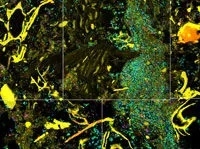Microbes in Space: An Interview with MBL's Jessica Mark Welch | Lab Animal


There's a lot of bacteria to consider in the microbiome—the Human Microbiome Project calculated that the normal human microbiome contains over 10,000 different species—and knowing who they all are can help researchers understand the interactions between microbes and their hosts, in sickness and in health. But “who's there” is just one question to ask when interrogating microbiomes. Jessica Mark Welch, a scientist at the Marine Biological Laboratory (MBL) in Woods Hole, MA and Gary Borisy at the Forsyth Institute in Cambridge, MA, are interested in identifying where all those bacteria are as well.
“Bacteria respond to their environment, and a key part of their environment is the other bacteria that are in there with them, the other bacteria that they're next to,” Mark Welch explains. “We think that structure and function are very tightly related and that in order to really understand the function of microbial communities, we are going to have to understand their structure.” Read more of the article here.
Source: Microbes in Space | Lab Animal